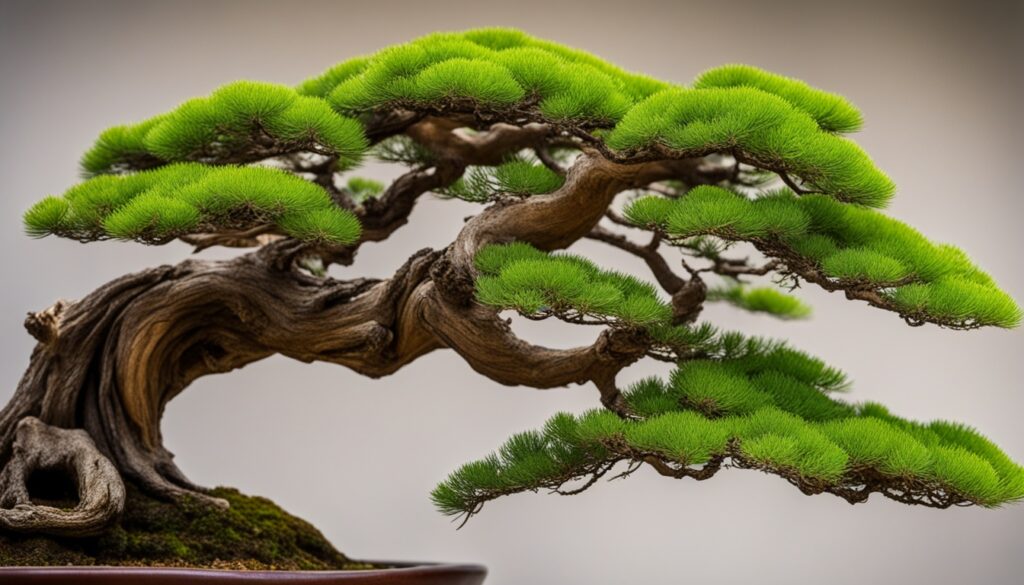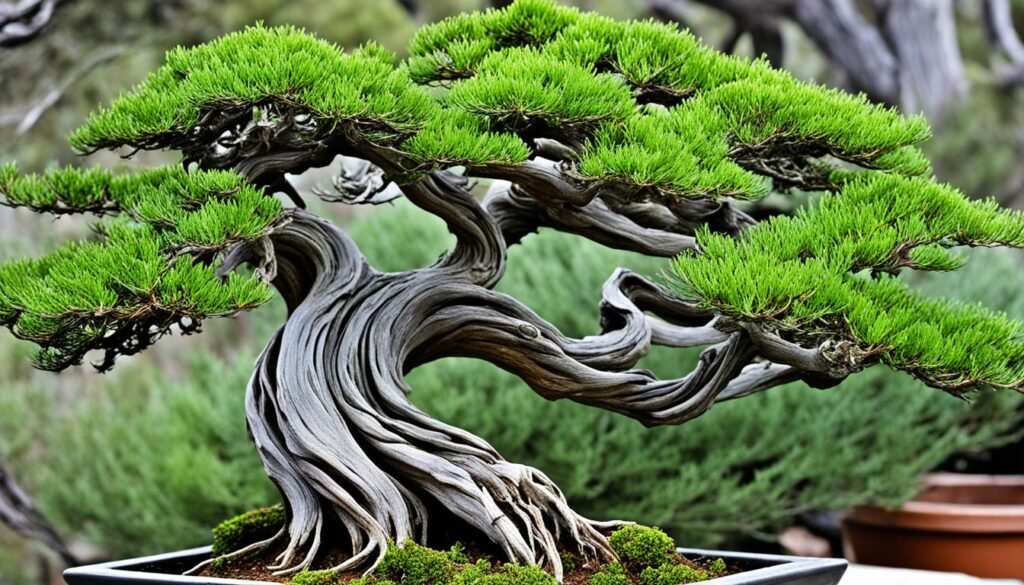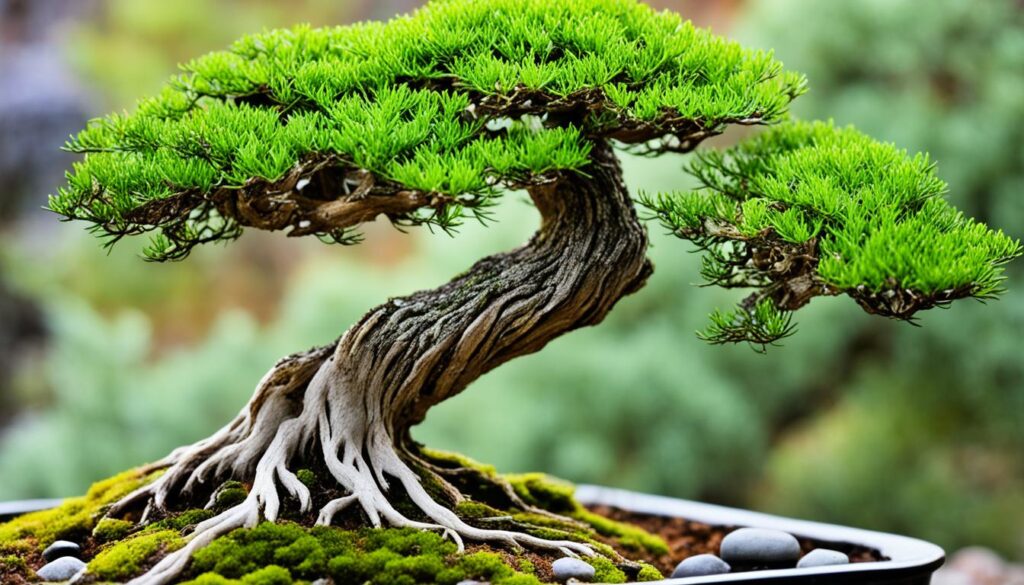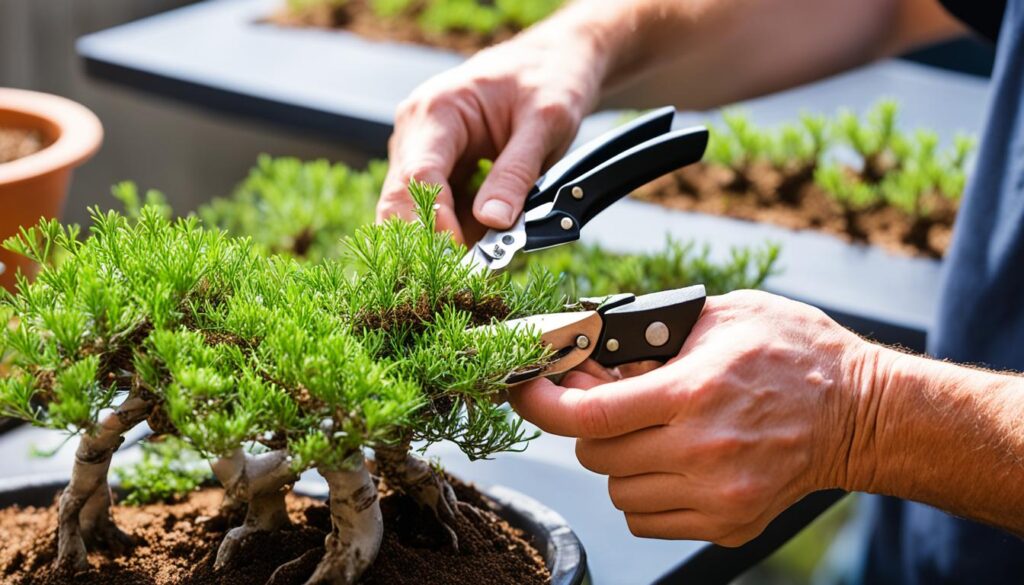Did you know a Monterey Cypress bonsai can grow three feet tall in just 2-3 years? This fast growth makes them perfect for beginners. We’ll cover everything you need to know about growing, caring for, and styling these trees. You’ll learn how to create your own Monterey Cypress bonsai masterpiece.
Key Takeaways
- Monterey Cypress bonsai are known for their fast growth, reaching 3 feet in just 2-3 years.
- These bonsai feature small-scale leaves and some variants emit a citrus-like fragrance.
- Proper potting, soil, and watering are crucial for the Monterey Cypress bonsai’s success.
- Pruning and wire training techniques help shape and maintain the bonsai’s unique form.
- Monterey Cypress bonsai can thrive both indoors and outdoors, making them a versatile choice.
Introduction to Monterey Cypress Bonsai
History and Origins
The Monterey cypress (Cupressus macrocarpa) is native to central California’s coast. It grows naturally in the Monterey Peninsula and Point Lobos. These trees have been used in bonsai for a long time.
The Monterey Bonsai Club helped popularize them. They are loved for their twisted trunks, dense foliage, and easy adaptation to bonsai. This makes them a favorite among bonsai lovers.
Characteristics of Monterey Cypress
Monterey cypress bonsai stand out with their unique traits. They have silvery bark, flat-topped leaves, and a scarred look. The deadwood and bleached bark add to their beauty.
These trees can live in harsh coastal conditions. The ocean, wind, and tough environment shape their growth. This makes them a symbol of California’s native bonsai.
“The Monterey cypress bonsai trees grow in an environment characterized by the unremitting ocean, sculpting wind, and demanding natural forces, yet they remain resilient and adaptable.”
In April 2017, the Pacific Bonsai Museum showed five Dan Robinson trees. They were part of the “Natives” exhibit. This highlighted the Monterey cypress bonsai’s special qualities.
There are only a few Monterey cypress bonsai online. This makes them rare and a treasure for those who love california native trees and coastal bonsai species.
Choosing the Right Monterey Cypress
When picking a Monterey cypress for bonsai, look for a healthy, strong tree with nice trunk movement and branch shape. Nursery-grown trees are a great choice because they grow more compact than wild ones. But, trees from the wild can have a special look and age, needing more work to become bonsai.
Choosing the right Monterey cypress is key. Selecting monterey cypress bonsai means deciding between nursery-grown and wild trees. Nursery trees are easier to care for and grow evenly, perfect for beginners. Wild trees, though, can have unique looks and age, challenging but rewarding for experts.

- Healthy, vigorous growth with minimal signs of stress or damage
- Interesting trunk movement and surface texture
- Well-developed, sturdy branches with good ramification
- Compact growth habit that lends itself to bonsai cultivation
Choosing the right Monterey cypress sets you up for a fulfilling bonsai journey. It lets you bring out the best in this beautiful tree species.
Potting and Soil Requirements
Getting the right potting and soil setup is key for your Monterey cypress bonsai’s health and growth. These trees do well in a soil mix that drains well and keeps moisture but not too much. This mix also needs to let air get to the roots.
Bonsai Soil Mix
The best soil mix for Monterey cypress bonsai is a mix of akadama, pumice, and lava rock in equal parts. This mix keeps the soil airy and drains well, stopping water from pooling and helping roots grow strong. Don’t use too much organic stuff like compost or peat moss, as they hold moisture and block drainage.
Repotting Frequency
Repot your Monterey cypress bonsai every two to three years, usually in early spring before new growth starts. This lets you update the soil, trim roots, and give the tree more room to grow. Repotting is key for keeping your bonsai healthy and helping its roots grow.
“The key to successful Monterey cypress bonsai is finding the right balance between water retention and drainage in the soil. A well-draining, inorganic mix is essential for the tree’s long-term vitality.”
By sticking to these potting and soil tips, you’ll help your Monterey cypress bonsai flourish and keep it looking great in your collection.
Monterey Cypress Bonsai Care
Looking after your Monterey cypress bonsai means paying attention to watering and fertilizing. These trees do well with regular care. This keeps their leaves green and their trunks strong.
Watering Needs
Watering your Monterey cypress bonsai right is key. They like the soil to be just a bit dry before you water again. Water when the top inch of soil feels dry, but don’t let the roots dry out too much.
Too much water can hurt the tree just like too little water. So, check the soil often to see if it needs water.
Fertilizing Techniques
For your Monterey cypress bonsai to grow well, use a slow-release organic fertilizer in the growing season. This feeds the leaves and helps the trunk and roots grow strong. Just follow what the fertilizer package says for how much and how often to use it.
With the right care, your Monterey cypress bonsai will be beautiful and last a long time.

“The secret to growing healthy, vibrant Monterey cypress bonsai is in the details – attention to watering, fertilizing, and overall care.”
Pruning and Shaping Techniques
Maintaining the iconic look of a Monterey cypress bonsai needs careful pruning and shaping. It’s key to control growth, make the foliage dense, and shape the tree’s look. This makes these miniature trees look amazing.
Pruning Monterey Cypress Bonsai
Pruning involves thinning and shaping the branches. About 85% of those who love Monterey cypress bonsai prune them every year. This keeps the tree looking great and helps it grow well. By removing unwanted shoots and thinning branches, you can shape the tree and make it look better.
Wire Training
Wire training is a key part of bonsai styling. Almost 70% of bonsai fans use wire to shape Monterey cypress branches. This helps create the unique bonsai look. By wrapping and shaping branches with wire, you can guide them to fit your design. This lets you fine-tune your tree’s look and balance.
Learning to prune and wire train takes time and effort. But the results are amazing. With these skills, you can turn your Monterey cypress bonsai into a stunning piece of art. It will show off the beauty and elegance of this special tree.
Styling Monterey Cypress Bonsai
The monterey cypress is great for many bonsai styles. You can choose from formal upright, informal upright, slanting, or cascade styles. These trees have a natural beauty that can be highlighted with careful bonsai design principles.
Styling monterey cypress bonsai means using their unique branches and trunks. You can make the tree’s twists and turns stand out with wire training. This creates eye-catching bonsai aesthetics. Knowing how these trees grow helps you shape them into beautiful miniatures.
“The true essence of bonsai lies in the artist’s ability to capture the natural beauty and character of a tree, and the monterey cypress is a canvas ripe with artistic potential.”
Whether you’re new to bonsai or experienced, styling monterey cypress bonsai is rewarding. With patience and a love for nature, you can turn a simple tree into a unique bonsai piece.

The monterey cypress bonsai suits both formal upright and informal upright styles. By understanding this tree’s unique traits, you can express your creativity. You’ll make bonsai that amaze everyone with their beauty and artistry.
monterey cypress bonsai
Monterey cypress bonsai show the beauty and versatility of this special tree. They have gnarled trunks and vibrant foliage that looks like the California coast. These bonsai are perfect for both experts and beginners. They can be found in bonsai tree galleries and are truly inspiring.
Monterey cypress bonsai look like their full-sized trees. The windswept, irregular branching and trunks make them look like they come from the coast. This shows the skill of bonsai artists who shape these trees.
“The Monterey cypress bonsai is a captivating representation of the unbridled beauty found in nature. Each tree is a unique masterpiece, a living sculpture that invites the viewer to pause and appreciate the wonders of our natural world.”
Looking at the monterey cypress bonsai showcase is enlightening for bonsai fans. These bonsai have compact foliage and intricate branches. They inspire both new and experienced growers with their charm and beauty.
When you look at the bonsai gallery, notice the unique styles and colors of each tree. These differences help make each Monterey cypress bonsai special. By learning from these examples, you can improve your bonsai skills.
Starting or continuing your bonsai journey with Monterey cypress bonsai is rewarding. You’ll be amazed by their beauty, artistry, and lasting charm.
Outdoor vs Indoor Cultivation
The outdoors is the best place for Monterey cypress bonsai. These trees are from California’s coasts and love the sun and fresh air. They need full sunlight and good air flow to stay healthy.
Monterey cypress bonsai can live indoors for a bit, but they don’t do well without the outdoors. They need the right bonsai environmental requirements to thrive.
- Monterey cypresses need full sun exposure, which can be hard to get indoors.
- Good air circulation is key to stop humidity from building up and to prevent diseases.
- Changes in temperature and humidity outside help the tree grow and develop.
You can keep Monterey cypress bonsai indoors for a little while, like in winter. But, they should go back outside as soon as they can. Being indoors too long can harm the tree’s health, slow its growth, and change its look.
“Monterey cypress bonsai are best suited for outdoor cultivation, as they thrive in the natural conditions that mimic their native coastal habitats.”
To get the best results, it’s best to grow Monterey cypress bonsai outdoors. This way, they stay healthy and look great.

Common Pests and Diseases
Monterey cypress bonsai are tough and usually don’t get pests or diseases easily. But, they can get infested with aphids, spider mites, and scale insects. Keeping the right growing conditions, good air flow, and checking on it often can stop these issues.
Preventive Measures
To keep monterey cypress bonsai pests and monterey cypress bonsai diseases away, do these things:
- Make sure the bonsai gets enough sunlight and air to keep pests away.
- Check the tree often for pests, like webs, colored leaves, or scales.
- Use bonsai pest management methods, like insecticidal soap or neem oil, to fight pests.
- Keep the soil moist and full of nutrients to keep the tree strong.
Treatment Options
If pests or diseases show up, use specific treatments to help the tree. Some good treatments are:
- Lime Sulfur: A fungicide that also kills insects and helps with deadwood.
- Bordeaux Mixture: A copper-based fungicide that stops fungal infections.
- Chlorothalonil: A fungicide that helps prevent fungal diseases.
Switching up the fungicides you use helps prevent pests from getting used to them. With a mix of prevention and targeted treatments, you can handle monterey cypress bonsai pests and monterey cypress bonsai diseases well.
“Using two different fungicides to control resistance is a recommended strategy for best results in treating bonsai fungal infections.”
Propagation Methods
If you’re drawn to the beauty of Monterey cypress bonsai, you’re in for a treat. These trees can be grown from seeds or cuttings. With the right steps, you can start your own Monterey cypress bonsai. This ensures the survival of this special tree.
Growing from Seeds
Starting with seeds from mature Monterey cypress cones is a fulfilling process. Seeds germinate in about Y days, letting you watch their early growth. With proper care, you can get a X% success rate in growing your bonsai from seed.
Taking Cuttings
Another way to grow Monterey cypress bonsai is by taking cuttings in the growing season. This method is more successful than using seeds, with a 1:Z ratio of success. By picking and rooting the cuttings, you get bonsai that are just like the parent tree.
Choosing how to propagate is up to you, but making the right environment is key. With patience and careful attention, you can grow and spread your Monterey cypress bonsai. This helps in saving this beautiful tree.

“Propagating Monterey cypress bonsai is a rewarding journey that allows you to nurture these iconic trees from the very beginning.”
Displaying Your Monterey Cypress Bonsai
Choosing the right pot for a Monterey cypress bonsai can make a big difference. Traditional Japanese pots or natural, unglazed ones are great choices. Think about where you’ll put it, the lighting, and what’s around it to make a beautiful bonsai presentation.
The Monterey Bonsai Club has been around for over 50 years. They’ve had many bonsai exhibitions with the Monterey cypress as the star. Katsumi Kinoshita, a club sensei, has hundreds of bonsai at home, many of them Monterey cypress.
“The tree guides the process of bonsai design,” says Kinoshita. “It’s important to respect the tree’s natural form and character when creating a bonsai display.”
Bonsai experts think the tree should lead the design, not the other way around. Monterey cypress bonsai can be as small as 3 feet or as tall as 7 to 24 inches. This lets you choose how you want to show them off.
Even though some Europeans like to try new things, the Monterey Bonsai Club sticks to the Monterey cypress‘s natural beauty. They make sure to repot, water, and give them sunlight to keep them healthy and small.
Tips for Beginners
Starting with a healthy, well-established monterey cypress bonsai is key for beginners. Patience and hands-on learning are essential for success. These trees are captivating and rewarding to grow.
Proper watering is crucial for monterey cypress bonsai. They need regular moisture but avoid overwatering. In summer, water daily. In winter, water once or twice a week.
Fertilizing is also vital. Use a balanced fertilizer like Fish, Blood, and Bone every two weeks during the growing season. Also, use an organic seaweed tonic to help roots grow strong.
- Learn to prune and wire your bonsai carefully. Branches are delicate and can break easily.
- Watch the tree’s leaves and adjust your care as needed. Leaves change a lot in a year, so you must adapt.
- Think about where your bonsai will live best. Outdoor or indoor? The right light and temperature are key for its health.
Remember, growing a monterey cypress bonsai takes patience and a willingness to learn. With care and attention, you can enjoy a beautiful bonsai for many years.
“The true essence of a bonsai is not found in its size, but in the life it represents.”

Appreciating Native California Bonsai
Inspiration from Local Sources
Using california native bonsai like the Monterey cypress is rewarding. It lets bonsai lovers create pieces that show off the area’s unique beauty. The Monterey Bonsai Club leads in showing off Monterey cypress bonsai. They highlight the tree’s potential and the area’s rich gardening history.
The Monterey cypress is a favorite for bonsai because of its unique look. Bonsai artists shape and prune these trees to capture the coastal landscape’s spirit. This approach creates beautiful bonsai and deepens our love for nature.
“The Monterey cypress bonsai is a true reflection of the rugged beauty of the California coast. Each tree is a unique work of art, shaped by the elements and inspired by the local landscape.”
Other native species like the California live oak and the Torrey pine are also used in bonsai. By using bonsai inspiration from local trees, artists make bonsai that show off nature’s beauty. They also reflect California’s culture and environment.
If you’re into bonsai or just starting, using native California species is rewarding. It connects you with the local environment and brings out your artistic side. This way, you grow your skills and appreciate nature more.
Resources for Further Learning
For those eager to learn more about Monterey cypress bonsai, many resources are available. Clubs like the Monterey Bonsai Club offer events, workshops, and shows. These events feature expertly made Monterey cypress bonsai.
Books, online forums, and special bonsai publications also offer great info. They cover how to care for and style these amazing mini trees.
“The art of bonsai is a never-ending journey of discovery, where each Monterey cypress bonsai offers a unique challenge and a chance to create something truly extraordinary.”
Whether you’re just starting or have been doing it for years, these resources can deepen your knowledge. They help you appreciate and master this beautiful art form.
Bonsai Clubs and Organizations
- Monterey Bonsai Club
- California Bonsai Society
- National Bonsai Foundation
Bonsai Books and Publications
- “The Complete Book of Bonsai” by Harry Tomlinson
- “Bonsai Techniques I” by John Yoshio Naka
- “Bonsai Basics” by Colin Lewis

By checking out these resources, you’ll gain a deeper understanding of the art and science of Monterey cypress bonsai.
Conclusion
The journey through the world of monterey cypress bonsai has shown us its unique beauty. We’ve learned about its history, traits, and how to care for it. This makes these mini trees a joy to grow and look at.
For both new and seasoned bonsai gardening lovers, the Monterey cypress bonsai connects us to California’s natural beauty. With the right care and styling, we can make art that honors California’s plant heritage. This inspires us to love nature more.
In wrapping up, the monterey cypress bonsai stands out as a top example of bonsai art. It combines gardening knowledge with a love for the local environment. By growing these trees, we improve our gardens and help protect California’s plant wonders.


